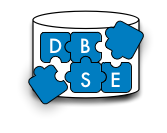Abschlussarbeiten
Bei Fragen zu den hier angebotenen Themen wenden Sie sich bitte an die jeweiligen Betreuer. Weitere Themen können in der Regel direkt bei den Mitarbeitern der Arbeitsgruppe erfragt werden. Abschlussarbeiten können wahlweise auf englisch oder deutsch verfasst werden.
Themen für Abschlussarbeiten
Die folgenden offenen Themen bieten wir derzeit für Bachelor- und Masterarbeiten an (bitte anklicken).
Database Topics
- Insights from Optane PMEM - A Survey
| Supervisor: | Sajad Karim |
| Abstract: | Non-volatile memory (NVM), or persistent memory, is a promising and emerging storage technology that has not only disrupted the typical long-established memory hierarchy but also invalidated the proclaimed programming paradigm used in traditional database management systems and file systems. [NVM1, NVM2, NVM3, NVM4, IDS1, IDS2, DB1 , DB2 , DB3 , DB4 , DB5] - It bridges the gap between primary and secondary storage - Shares the characteristics of both categories. - Nonvolatile, offers latency close to DRAM, and entails higher capacity than DRAM. - Byte-addressable The primary goal of this exercise is to conduct a comprehensive survey of the applications and performance implications of byte-addressable persistent memory (PMEM), with a focus on emerging technologies such as Intel Optane DC Persistent Memory Modules. This work aims to systematically review the current state of research, classify application scenarios, and evaluate the design trade-offs associated with different operational modes (e.g., Memory Mode, AppDirect Mode, and mixed configurations). This work should synthesize experimental results, benchmark studies, and design techniques from various domains—including in-memory databases, file systems, and high-performance computing to provide an in-depth analysis of the impact of DC PMEM on these applications/domain, while also identifying gaps and future research directions. |
| Goals and results: | 1. Literature Review
|
- NVM-optimized Bepsilon-tree
| Supervisor: | Sajad Karim |
| Abstract: | Non-volatile memory (NVM) is a new class in the traditional storage hierarchy. The technologies in this class share the characteristics of primary and secondary storage. They provide access latency close to DRAM, are addressable from cache lines, offer much higher capacity than DRAM, and are non-volatile. NVM is also often referred to as a disruptive memory technology as it has invalidated the traditional programming paradigm because, contrary to the traditional model, where data structures are generally categorized into memory and storage resident data structures, NVM-bound data structures cover both the aspects and the linked intricacies. Moreover, there has been considerable research made to leverage the characteristics of NVM, and in particular to the task mentioned in this posting, several designs for the index structures (e.g. wB+-Tree, NV-Tree, FP-Tree, LB+-Tree) [4, 5, 6, 7] that are typical to key-value storage engines are presented. However, one of the key aspects that is not addressed in the mentioned literature is they do not consider the heterogeneity of the modern storage landscape. For example, they all present NVM-DRAM optimized B-trees and do not consider block devices like SSD and HDD. Furthermore, and to the best of our knowledge, no research has been made to optimize Bepsilon-tree [1, 2, 3] for NVM despite the fact it offers similar scan operations as other B-tree variants yet its inserts and deletes are an order of magnitude faster. |
| Goals and results: | The goal is to implement an NVM-optimized Bepsilon-tree. It includes reviewing the recent literature and proposing data structures for the internal and leaf nodes in the B?-tree that would leverage the characteristics of NVM. Moreover, our server is equipped with the NVM module from Intel® (Intel® Optane™ DC Persistent Memory Modules), therefore, the proposed layouts should consider the characteristics of the module [8]. For example, the read and write latencies of the module are asymmetric where the reads are faster than the writes. Lastly, the proposed design has to be evaluated against the typical DRAM-based and disk-based Bepsilon-trees. [1] Rudolf Bayer and Edward McCreight. 1970. Organization and Maintenance of Large Ordered Indices. In Proceedings of the ACM SIGFIDET (now SIGMOD) Workshop on Data Description, Access and Control (Houston, Texas). Association for Computing Machinery, New York, NY, USA, 107–141. [2] Gerth et al. 2003. Lower bounds for external memory dictionaries.. In SODA, Vol. 3. 546–554. [3] Michael A Bender, Martin Farach-Colton, William Jannen, Rob Johnson, Bradley C Kuszmaul, Donald E Porter, Jun Yuan, and Yang Zhan. 2015. An Introduction to B? -trees and Write-Optimization. login; magazine 40, 5 [4] Shimin Chen and Qin Jin. 2015. Persistent B+-trees in non-volatile main memory. Proc. VLDB Endow. 8, 7 (February 2015), 786–797. [5] FPTree: A Hybrid SCM-DRAM Persistent and Concurrent B-Tree for Storage Class Memory. [6] Jihang Liu, Shimin Chen, and Lujun Wang. 2020. LB+Trees: optimizing persistent index performance on 3DXPoint memory. Proc. VLDB Endow. 13, 7 (March 2020), 1078–1090. [7] Y. Zhou, T. Sheng and J. Wan, "HBTree: an Efficient Index Structure Based on Hybrid DRAM-NVM," 2021 IEEE 10th Non-Volatile Memory Systems and Applications Symposium (NVMSA), Beijing, China, 2021, pp. 1-6, doi: 10.1109/NVMSA53655.2021.9628870. [8] Lessons learned from the early performance evaluation of Intel optane DC persistent memory in DBMS. 10.1145/3399666.3399898 |
Software Engineering Topics
- Advanced Topics in Feature-Model Analysis
| Supervisor: | Elias Kuiter |
| Abstract: | This is an overview of thesis topics and software projects concerned with feature-model analysis. To work on one of these topics or projects, you must have successfully participated in our lecture on software product lines. |
| Slides: |
Wissenschaftliche Teamprojekte
Für wissenschaftliche Teamprojekte bieten wir eine eigene Veranstaltung an:
Zu Beginn dieser Veranstaltung werden verschiedene Themen vorgestellt, die innerhalb des Semesters bearbeitet werden können
Individualprojekte können mit Mitarbeitern auf Anfrage ebenfalls vereinbart werden.
Softwareprojekte
Es stehen derzeit folgende Themen für ein Softwareprojekt zur Verfügung.
- Advanced Topics in Feature-Model Analysis
| Supervisor: | Elias Kuiter |
| Abstract: | This is an overview of thesis topics and software projects concerned with feature-model analysis. To work on one of these topics or projects, you must have participated in our lecture on software product lines. |
| Slides: |
Vorlagen
Abschlussarbeiten
- LaTeX-Vorlagen für deutsche und englische Arbeiten
- Microsoft Word-Vorlage: DOT
